Workforce Management Solutions to Streamline Processes
Labor experienced an unprecedented transformation within the last three years. Businesses were compelled to reevaluate how and where we work, and as we continue returning to offices and navigating hybrid work schedules, industries are assessing how they manage and monitor personnel. Skilled software developers have designed and enhanced time and attendance software programs to provide industries with a much-needed resource to streamline functionality and ensure accurate personnel attendance monitoring.
The value of time and attendance resources are often overlooked, as personnel view them as a mere formality of daily work schedules. Still, Allied Market Research has valued the global market share for time and attendance software resources at $2.7 billion, affirming the continued need for optimized time and attendance programs within all industries. These software-based resources are evergreen because no matter the specific industry, every business must deploy a system to monitor and manage personnel time and attendance efficiently, analyze productivity, and efficiently complete human resources and payroll processes without interrupting workflow.
Custom Attendance Management Systems
Thanks to software specialists, attendance management systems have enjoyed a steady evolution in functionality, replacing yesterday’s archaic ‘punch the clock’ machines. Today’s modern attendance management systems streamline administrative tasks, such as shift scheduling, employee training completion rates, and quick displays of earned leaves and benefits. The key to effective attendance management systems is ease of accessibility and opportunities for customization.

Software specialists offer an array of customizations to fit any business strategy. Reporting tools such as absence levels, training completion rates, productivity, and other custom parameters via intuitive dashboards enable businesses to glean greater data-driven insights into human capital management. Human Capital Management (HCM), a critical sector of human resources, has demanded greater tech-driven strategies to meet the evolving business landscapes we have seen within the last few years not only sparked by the global pandemic, but ambitious business strategies requiring fresh approaches to achieve success.
Biometrics security and attendance management systems continue to enjoy swift growth in market share, with MarketsandMarkets reporting $42 billion in revenue for 2022. Biometrics eliminates time-intensive tasks associated with personnel tracking, attendance, and benefits monitoring by utilizing an all-encompassing hardware resource driven by software tech to capture unique features such as fingerprints, voice, or eyes and generate data reports for time and attendance tasks. This provides unparalleled security and eliminates employee time theft. Society for Human Resource Management, a leading trade and advocacy organization, cites a rise in employee time theft but reported no federal law decreeing employee time theft illegal in the U.S. Still, the actions are classified as employee misconduct.
The Most Common Examples of Employee Time Theft
- Excessive breaks
- ‘Buddy Punching’. This is when one employee manipulates a time clock/card on behalf of another co-worker to record hours supposedly worked or to conceal tardiness.
- Late Arrivals, Early Departures of Personnel.
- Poor Time Management, Failure to Complete Tasks in Allotted Time
Utilizing biometrics for employee time and attendance eliminates ‘buddy punching’ because it requires unique, individual traits such as fingerprints as verification for gaining building access and reporting to work. Biometrics driven by software workforce management solutions provides a simple, user-friendly database to compile all hours worked and upcoming schedules accurately and even disseminate information about individualized benefits and training.
Human Capital Management Software Development
Human Capital Management (HCM) is a critical sector within the human resources industry because its focus is vetting and hiring candidates, managing workflow processes, and compliance. With the labor landscape’s dramatic shift, HCM demands have grown. Incorporating technology and data insights has required the skills of dedicated software developers who are well-versed in this rapidly growing industry. MarketsandMarkets, a leading research firm dedicated to industry trends and supporting statistics, reported the global market for HCM exceeded $22.3 billion in 2021 and forecasts $32 billion by 2026.
Human Capital Management resources have shifted from on-premises to Cloud-based platforms, enabling greater opportunities to automate recruitment, talent acquisition, payroll, benefits, and other administrative tasks. The evolution of Artificial Intelligence enhanced by software specialists has augmented and modernized businesses, attributed to its versatility and ability to provide automation and create data-driven decisions and error-free reporting critical to successfully implementing strategies.
The application of AI within HCM has fully optimized human resources processes. Vetting talent with AI-driven HCM resources leverages powerful, customized algorithms to streamline the application process. Desired candidate traits are carefully identified utilizing semantic skills extraction programs, augmented by software specialists to reduce time spent on applicants who are not accurate matches for advertised roles. Additionally, predictive analytics customized by software experts can assist human resources in making more informed forecasts on the longevity of applicants by utilizing data generated by analytics.
Artificial Intelligence creates new opportunities to generate actionable insights into personnel performance, enabling management and human resources to create additional support strategies. AI-driven analytics provide additional data focused on performance metrics that AI specialists can customize to operate algorithms within specified parameters.
Optimizing Compliance Management Software
Compliance management software enables adherence to even the most stringent policy changes, assuring your business follows protocol and completes all requirements efficiently. Clearly defining your business’s policies and procedures reduces careless and costly efforts, promoting smooth operations and project completions and ensuring all personnel comply with federal and local regulations. Within this scope, human resources is responsible for maintaining compliance and bridging the gap between management and personnel when disseminating pertinent information. Typical compliance focuses on the following areas, and tools like Factorial Software can help streamline these processes:
- Recruitment and Talent Acquisition; Discriminatory Practices
- Health Benefits
- Exempt vs. Non-Exempt Staff
- Document Processing; Identity Confirmation and Tax Withholdings
- Payroll Processing
- Training, Breaks, Travel, Reimbursements
With a considerable amount of compliance factors that can prove very costly to businesses if there is any deviation, businesses continue to look to software-based workforce management solutions to augment human resources, maintain compliance, promote cost-saving strategies, and ensure future compliance amidst ever-changing business landscapes.
Designing and deploying AI tools and chatbots can best assist personnel inquiring about health benefits or confirming exempt or non-exempt status, just an array of important facts confirmed expediently by chatbots that can further assist human resources officials in providing the best and most accurate information to personnel in the most timely manner. Automating document processing has reduced repetitive tasks, allowed human resources officials to reprioritize tasks, and provided confidence that pertinent documents are completed error-free.
Integrated Payroll Services
Proper payroll management is integral to business functionality and can be costly if mismanaged. Payroll is not strictly limited to calculating hours worked and properly calculating salaries; it is far greater in scope and includes taxes, accruals, pensions, and deductions. Software workforce management solutions offer integrated payroll strategies, including an array of human resources programs creating a unified resource for businesses to enhance their human resources and automate several payroll services to deploy a fully optimized and integrated service.
Software specialists leverage Artificial Intelligence to automate payroll processes, and with the ability to accurately manage large volumes of data, payroll services driven by AI provide a modern resource to assist large businesses with greater payroll demands. For companies implementing hybrid schedules, working with an array of freelancers, or utilizing global talent, AI-driven software workforce management solutions streamline the entire data collection process and properly calculate pay rates and deductions, eliminating human error and reducing delays in payroll completion.
Integrated payroll services are just another avenue provided by software specialists to merge overlapping human resources and payroll processes, optimizing business functionality and reducing expenses and service duplication.
Augmenting Workforce Management
Chetu’s software specialists augment workforce management by leveraging cutting-edge resources to optimize operations. Human resources continue to become an all-encompassing foundation for successfully managing businesses, and as business demands continue evolving, human resources must seek new resources to modernize processes further.
Chetu’s Artificial Intelligence experts enhance this resource to provide customized, versatile workforce management solutions to streamline human resources processes, such as compliance and document processing, enabling expedited and error-free automation of tasks critical to ensuring uninterrupted workflow and elevated support of all personnel.
Studies have concluded that employee time theft continues to impact companies. Chetu’s custom time and attendance software workforce management solutions ensure that personnel adhere to proper work schedules and utilize company time. Biometric attendance software eliminates ‘buddy punching’ and enhances building security, confirming that only required personnel and preapproved guests gain entry. By customizing biometrics hardware, personnel can seamlessly access individualized dashboards displaying schedules, benefits, accruals, and other pertinent information tailored to each employee. This facilitates more transparency and accurate communication of critical information from human resources.
Conclusion
With today’s workforce experiencing great transformation attributed to the global pandemic and businesses seeking new strategies to modernize operations and grow revenue, Chetu provides customized workforce management solutions to not only support existing workforce infrastructure but facilitate its great leap forward by providing actionable insights to promote data-driven decisions to move business ahead.




Leave a Reply